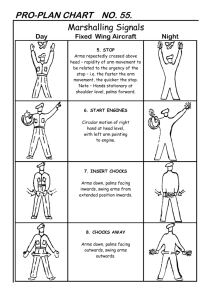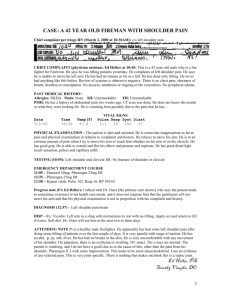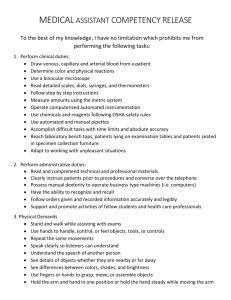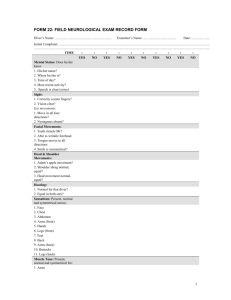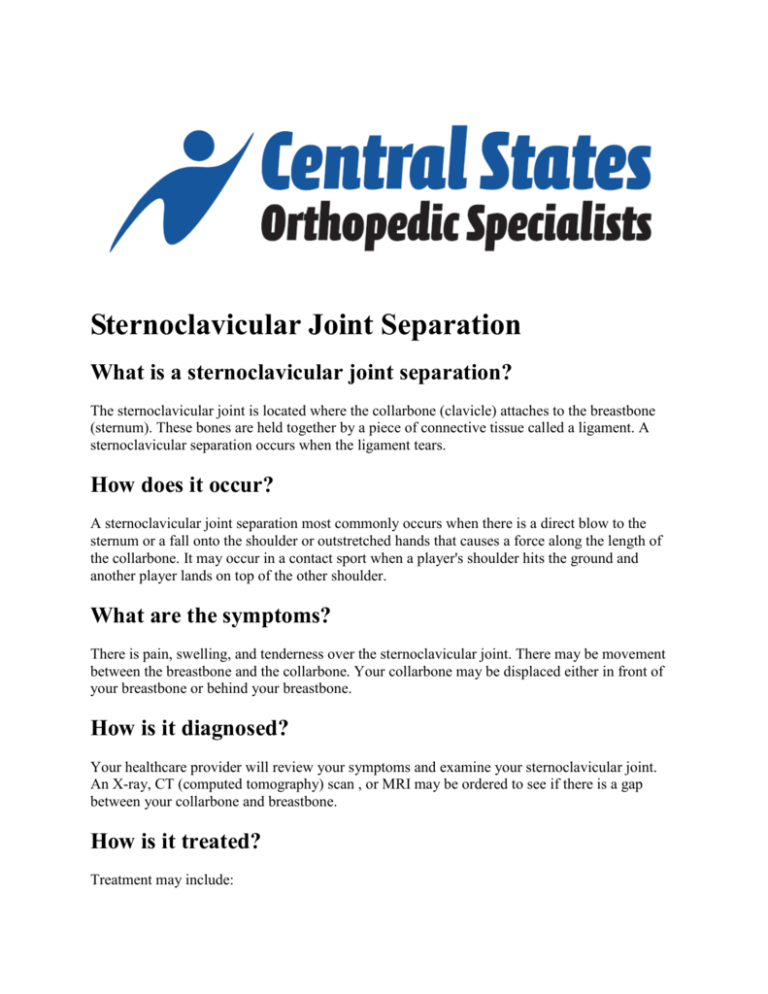
Sternoclavicular Joint Separation
What is a sternoclavicular joint separation?
The sternoclavicular joint is located where the collarbone (clavicle) attaches to the breastbone
(sternum). These bones are held together by a piece of connective tissue called a ligament. A
sternoclavicular separation occurs when the ligament tears.
How does it occur?
A sternoclavicular joint separation most commonly occurs when there is a direct blow to the
sternum or a fall onto the shoulder or outstretched hands that causes a force along the length of
the collarbone. It may occur in a contact sport when a player's shoulder hits the ground and
another player lands on top of the other shoulder.
What are the symptoms?
There is pain, swelling, and tenderness over the sternoclavicular joint. There may be movement
between the breastbone and the collarbone. Your collarbone may be displaced either in front of
your breastbone or behind your breastbone.
How is it diagnosed?
Your healthcare provider will review your symptoms and examine your sternoclavicular joint.
An X-ray, CT (computed tomography) scan , or MRI may be ordered to see if there is a gap
between your collarbone and breastbone.
How is it treated?
Treatment may include:
Putting ice packs on the injury for 20 to 30 minutes every 3 to 4 hours for 2 to 3 days or until the
pain goes away.
Taking anti-inflammatory medicine or pain medicines prescribed by your healthcare provider.
Adults aged 65 years and older should not take non-steroidal anti-inflammatory medicine for
more than 7 days without their healthcare provider's approval.
Wearing a sling.
Resting your shoulder and arm on the side of the separation until the pain goes away.
In cases where the collarbone is forced behind the breastbone, there may be a risk of damage to
the heart or the blood vessels in the chest and surgery may be required to repair the separation.
In some cases, the sternoclavicular joint heals but may have some instability, or movement,
when you move your arm or shoulder. If this instability causes pain, your healthcare provider
may recommend surgery.
When can I return to my normal activities?
Everyone recovers from an injury at a different rate. Return to your activities will be determined
by how soon your injured area recovers, not by how many days or weeks it has been since your
injury has occurred. The goal of rehabilitation is to return you to your normal activities as soon
as is safely possible. If you return too soon you may worsen your injury.
You may safely return to your normal activities when:
You no longer have pain at the sternoclavicular joint.
You have full range of motion and strength of your shoulder.
How can I prevent a sternoclavicular joint separation?
A sternoclavicular joint separation is usually caused by an accident that cannot be prevented.
Written by Pierre Rouzier, MD, for RelayHealth.
Published by RelayHealth.
Last modified: 2008-08-11
Last reviewed: 2008-07-07
This content is reviewed periodically and is subject to change as new health information becomes
available. The information is intended to inform and educate and is not a replacement for medical
evaluation, advice, diagnosis or treatment by a healthcare professional.
Sports Medicine Advisor 2009.1 Index
Sports Medicine Advisor 2009.1 Credits
Sternoclavicular Joint Separation
Rehabilitation Exercises
Chest stretch: Grasp your hands behind your back and lift your arms away from your body. Hold
15 to 30 seconds. Repeat 3 times.
Shoulder flexion: Stand with your arms hanging down at your side. Keep your elbow straight
and lift your arms up over your head as far as you can reach. Hold the end position for 5
seconds. Do 3 sets of 10.
Scaption: Stand with your arms at your sides and with your elbows straight. Slowly raise your
arms to eye level. As you raise your arms, they should be spread apart so that they are only
slightly in front of your body (at about a 30 degree angle to the front of your body). Point your
thumbs toward the ceiling. Hold for 2 seconds and lower your arms slowly. Do 3 sets of 10. Hold
a soup can or light weight when doing the exercise and increase the weight as the exercise gets
easier.
Single-arm shoulder abduction: Stand with your arms at your sides with your palms resting
against your sides. With your elbow straight, lift one arm out to the side and toward the ceiling.
Hold the position for 5 seconds. Repeat 10 times. Add a weight to your hand as this exercise
becomes easier.
Shoulder horizontal abduction (single arm): Standing with your arm out in front of you, elbow
straight and at shoulder level, move your arm in a horizontal direction out to the side. Return to
the starting position. Repeat 10 times.
Scapular squeeze: While sitting or standing with your arms by your sides, squeeze your shoulder
blades together and hold for 5 seconds. Do 3 sets of 10.
Supine shoulder flexion: Lie on your back, hold your arm out straight, and move your arm up
until your hand is toward the ceiling. Return your arm to the starting position. Do 3 sets of 10.
As you get stronger, hold a weight in your hand as you do this exercise.
Prone shoulder extension: Lie on your stomach on a table or a bed with one arm hanging down
over the edge. With your elbow straight, slowly lift your arm straight back and toward the
ceiling. Return to the starting position. Do 3 sets of 10. As this becomes easier, hold a weight in
your hand.
Horizontal abduction: Lie on a table or the edge of a bed face down with one arm hanging down
straight to the floor. Raise your arm out to the side, with your thumbs pointed toward the
ceiling until your arms are parallel to the floor. Hold for 2 seconds and then lower it slowly. Start
this exercise with no weight. As you get stronger add a light weight or hold a soup can. Do 3 sets
of 10.
Supine Chest Fly: Hold a small dumbbell in each hand and lie on your back with your knees bent,
arms out to your sides and elbows slightly bent. Slowly bring both arms across your chest until
the dumbbells touch. Lower slowly back to the starting position. Do 3 sets of 10. Gradually
increase the amount of weight in your hands.
Written by Tammy White, MS, PT, and Phyllis Clapis, PT, DHSc, OCS, for RelayHealth.
Published by RelayHealth.
Last modified: 2008-07-10
Last reviewed: 2008-07-07
This content is reviewed periodically and is subject to change as new health information becomes
available. The information is intended to inform and educate and is not a replacement for medical
evaluation, advice, diagnosis or treatment by a healthcare professional.
Sports Medicine Advisor 2009.1 Index
Sports Medicine Advisor 2009.1 Credits
© 2009 RelayHealth and/or its affiliates. All Rights Reserved.




